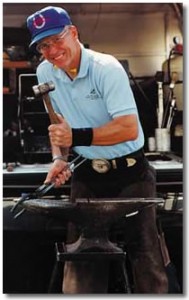Positive Changes in the Farrier Industry
There have been many changes in the farrier industry in the past 60 years since I shod my first horse. Some are more important than others. All have increased the income and prestige of the farrier as a professional craftsman and tradesman.
- Horse population increase. Horse population and popularity as a recreational outlet has increased. In 1960 the USDA reported the lowest numbers of horses since they began counting them in the late 1800s. Horse related occupations were considered antiquated and ‘out of date.’ Today the popularity of rodeo, horse show and equine recreational events is at an all time high. First time horse owners are increasing as people move to areas where they can keep horses. Most need the services of a qualified farrier.
- Learning materials. More choices of horse care information are available through books, videos and the internet today. Farriers can choose from many more clinics and seminars than were previously available. However, it is wise to do some research before investing in schools and other learning resources that may be faddish and unsound. More attention needs to be paid to personal and business management.
- Tools. A great variety of tools are available today. Many forging tools had to be handmade by farriers until just a few years ago. Most companies that made good horseshoeing tools were extinct by the 1960s. Now superior hoof and forging tools are readily available from a large number of suppliers. Many upper level farriers have specialized in tool making. Tools are manufactured in and imported from many nations. They vary tremendously in quality and price.
- Horseshoes and pads. Hundreds of types and styles of ready-made shoes are available, many from other countries. Just a few years ago there were only a few domestic shoe manufacturers. Styles and designs have greatly improved. A variety of materials are used. The heels are finished smooth and shoes come in half-sizes eliminating the need to cut and finish them. Nail holes are clean (they don’t have to be pritcheled out) and are more accurately placed in the shoe to allow for wall thickness. More nail holes give a better choice when the wall is broken or horses are shod frequently. Pads are made of various materials and hoof patching materials have been greatly improved since I first researched them in the 1960s as part of my Master’s thesis.
- Networks. Farriers have more networks available to learn from each other. Conventions, seminars and clinics accompanied by trade shows make these opportunities available. Farriers must choose those that have the most potential for teaching the things they need at any given time in their career. The internet and social media sites have contributed to building a farrier community but these also have the potential for abuse and time-wasting that can hurt business.
- Competitions and certifications. There has been a great increase in opportunities to improve skill. Preparing for competitions and certifications creates a self-applied pressure to reduce time and increase skill which can translate to higher income and greater job satisfaction. Working against the clock is a great way to create the pressure needed to improve oneself. However, obsession with these events can become addictive and may displace important business and family-life concerns.
- Tranquilizing drugs. Years ago there were few drugs that worked well to subdue an uncooperative horse owned by an unknowledgeable person. Ropes and other restraints were often needed. Now there are safe and effective drugs that can be administered by a veterinarian that reduce the risk of shoeing a fractious horse. Horse training methods are more widely practiced that can make the farrier’s job easier.
A well-trained and experienced professional farrier has more opportunity than ever before to make a good income and live a satisfying life. There is a lot to be grateful for! What you do with this fabulous opportunity is entirely up to you!
Related Posts
-
Professional farriers demonstrate their work is a legitimate...Jan 24, 2019 / 0 comments
-
We all value our animals — both in terms of money and our ...Aug 23, 2018 / 0 comments
-
Happy New Year! The New Year brings with it a determination ...Jan 30, 2015 / 0 comments
Blog Categories
- Anatomy
- Best Business Practices
- Conformation
- Current Events
- Customer Service
- Draft Horse Shoeing
- Equine Soundness
- Essential Anatomy Kit
- Farrier Careers
- Farrier training
- Foal soundness
- Horse Care
- Horse Foot Care
- Horse Owner Tips
- Horsemanship
- Horseshoeing
- Horseshoeing History
- Iron and Forge Work
- Student Spotlight
- Uncategorized
- Veterinary Care
Blog Archives
Contact Us
Butler Professional Horseshoeing School
495 Table Road
Crawford, NE 69339
(800) 728-3826
jacob@dougbutler.com
Subscribe to Our Blog
Get Our Free e-Book!
If you think you want to become a farrier (or know someone who does), this book can help you make that decision. Horse owners will learn the importance of choosing a qualified farrier and how to select the “right” one.
[ Get the e-Book Now! ]
- Follow:

